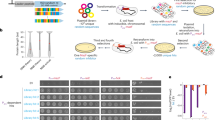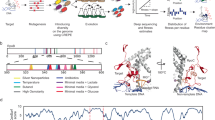Abstract
Pseudogenes represent open reading frames that have been damaged by mutations, rendering the gene product non-functional. Pseudogenes are found in many genomes and are not always eliminated, even if they are potentially ‘wasteful’. This raises a fundamental question about their prevalence. Here we report pseudogene efeU repair that restores the iron uptake system of Escherichia coli under a designed selection pressure during adaptive laboratory evolution.
This is a preview of subscription content, access via your institution
Access options
Access Nature and 54 other Nature Portfolio journals
Get Nature+, our best-value online-access subscription
$29.99 / 30 days
cancel any time
Subscribe to this journal
Receive 12 digital issues and online access to articles
$119.00 per year
only $9.92 per issue
Buy this article
- Purchase on Springer Link
- Instant access to full article PDF
Prices may be subject to local taxes which are calculated during checkout


Similar content being viewed by others
Code availability
All code used to analyse the data is available at https://github.com/SBRG/mutation_analysis.
Data availability
DNA sequencing data from this study are available from the Sequence Read Archive database (SRA accession PRJNA505542). RNA sequencing data from this study are available from the Gene Expression Omnibus database under the accession number GSE122779.
References
Ratledge, C. & Dover, L. G. Annu. Rev. Microbiol. 54, 881–941 (2000).
Pi, H. & Helmann, J. D. Proc. Natl Acad. Sci. USA 114, 12785–12790 (2017).
Grosse, C. et al. Mol. Microbiol. 62, 120–131 (2006).
Wattam, A. R. et al. Nucleic Acids Res. 45, D535–D542 (2017).
Conrad, T. M., Lewis, N. E. & Palsson, B. Ø. Mol. Syst. Biol. 7, 509 (2011).
Sandberg, T. E. et al. PLoS ONE 11, e0151130 (2016).
Zhou, K., Aertsen, A. & Michiels, C. W. FEMS Microbiol. Rev. 38, 119–141 (2014).
Miethke, M., Monteferrante, C. G., Marahiel, M. A. & van Dijl, J. M. Biochim. Biophys. Acta 1833, 2267–2278 (2013).
Seo, S. W. et al. Nat. Commun. 5, 4910 (2014).
Tutar, Y. Comp. Funct. Genomics 2012, 424526 (2012).
Kuo, C. H. & Ochman, H. PLoS Genet. 6, e1001050 (2010).
Lawrence, J. G., Hendrix, R. W. & Casjens, S. Trends Microbiol. 9, 535–540 (2001).
Mira, A., Ochman, H. & Moran, N. A. Trends Genet. 17, 589–596 (2001).
Thomason, L. C., Costantino, N. & Court, D. L. Curr. Protoc. Mol. Biol. 79, 1.17.1–1.17.8 (2007).
Baba, T. et al. Mol. Syst. Biol. 2, 2006.0008 (2006).
Datsenko, K. A. & Wanner, B. L. Proc. Natl Acad. Sci. USA 97, 6640–6645 (2000).
Zhou, K. et al. Int. J. Antimicrob. Agents 51, 822–828 (2018).
Fay, M. P. Biostatistics 11, 373–374 (2010).
Katoh, K., Rozewicki, J. & Yamada, K. D. Brief. Bioinform. https://doi.org/10.1093/bib/bbx108 (2017).
Touchon, M. et al. PLoS Genet. 5, e1000344 (2009).
Rambaut, A. FigTree v1.4.3 (Institute of Evolutionary Biology, University of Edinburgh, Edinburgh, 2018); http://tree.bio.ed.ac.uk/software/figtree/
Fleming, T. P., Nahlik, M. S. & McIntosh, M. A. J. Bacteriol. 156, 1171–1177 (1983).
Chen, S. et al. BMC Bioinform. 18, 80 (2017).
Deatherage, D. E. & Barrick, J. E. Methods Mol. Biol. 1151, 165–188 (2014).
Phaneuf, P. Zenodo v.1.4.1 (Zenodo, San Diego, 2018); https://doi.org/10.5281/zenodo.1301237
Phaneuf, P. V., Gosting, D., Palsson, B. & Feist, A. Preprint at bioRxiv (2018); https://www.biorxiv.org/content/biorxiv/early/2018/05/15/320747.full.pdf
Langmead, B., Trapnell, C., Pop, M. & Salzberg, S. L. Genome. Biol. 10, R25 (2009).
Lawrence, M. et al. PLoS Comput. Biol. 9, e1003118 (2013).
Love, M. I., Huber, W. & Anders, S. Genome Biol. 15, 550 (2014).
Yang, J. et al. Nat. Methods 12, 7–8 (2015).
Roy, A., Kucukural, A. & Zhang, Y. Nat. Protoc. 5, 725–738 (2010).
Zhang, Y. BMC Bioinform. 9, 40 (2008).
Acknowledgements
This work was funded by the Novo Nordisk Foundation under grant number NNF10CC1016517.
Author information
Authors and Affiliations
Contributions
A.A., A.M.F. and B.O.P. designed the study. A.A., C.A.O., S.X., Y.H. and R.S. performed the experiments. A.A., L.Y., A.V.S., C.A.O., E.C. and T.E.S. analysed the data. K.S.C. and P.V.P. contributed analysis tools. A.A. and B.O.P. wrote the manuscript.
Corresponding author
Ethics declarations
Competing interests
The authors declare no competing interests.
Additional information
Publisher’s note: Springer Nature remains neutral with regard to jurisdictional claims in published maps and institutional affiliations.
Supplementary information
Supplementary Information
Supplementary Figures 1–5, Supplementary Tables 1–6 and Supplementary References.
Rights and permissions
About this article
Cite this article
Anand, A., Olson, C.A., Yang, L. et al. Pseudogene repair driven by selection pressure applied in experimental evolution. Nat Microbiol 4, 386–389 (2019). https://doi.org/10.1038/s41564-018-0340-2
Received:
Accepted:
Published:
Issue Date:
DOI: https://doi.org/10.1038/s41564-018-0340-2
This article is cited by
-
Many purported pseudogenes in bacterial genomes are bona fide genes
BMC Genomics (2024)
-
A systems approach discovers the role and characteristics of seven LysR type transcription factors in Escherichia coli
Scientific Reports (2022)
-
Laboratory evolution of synthetic electron transport system variants reveals a larger metabolic respiratory system and its plasticity
Nature Communications (2022)
-
LncRNA EBLN3P promotes the progression of osteosarcoma through modifying the miR-224-5p/Rab10 signaling axis
Scientific Reports (2021)
-
The Escherichia coli transcriptome mostly consists of independently regulated modules
Nature Communications (2019)



